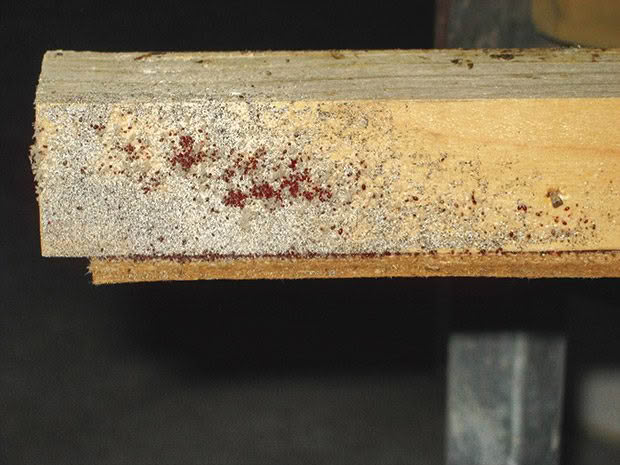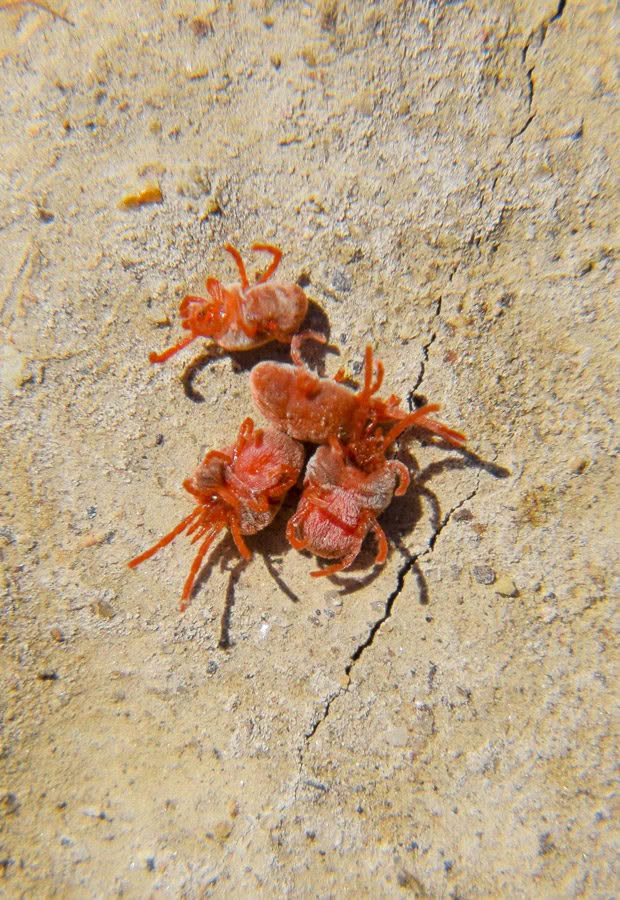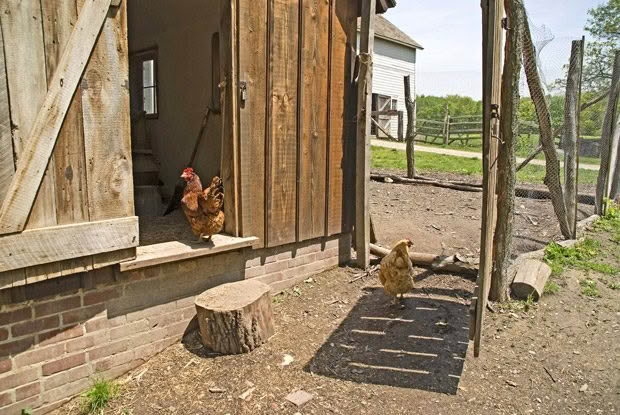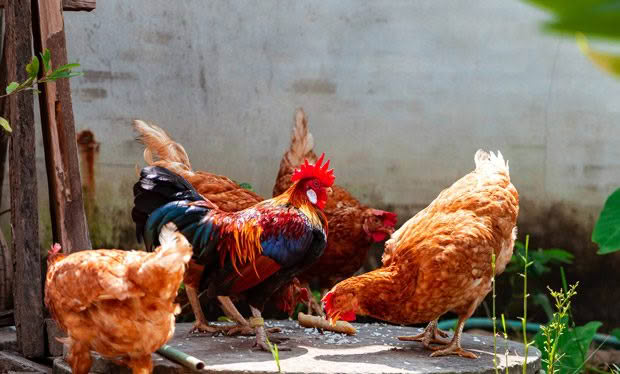How to prevent and eliminate red mites

Clumps of red mites on the inside of a coop.
Here’s how to fight one of the most frustrating problems for poultry owners that’s so small, it’s hard to spot.
Words: Nadene Hall
Red mites cause irritation, blood loss, which runs down a bird’s immune system, and carry diseases. Over time, they can be deadly due to anaemia, and their effect on a bird’s overall health.
Occurrence: common, can occur all year-round if it’s warm and humid enough. Can survive in the environment for up to 9 months after all birds have been removed from a coop. Mite eggs can remain viable for up to 2 years.
Where they’re found: on coop surfaces, perches, and in nests, cracks, and gaps in coop walls. They move onto poultry at night, staying on a bird for an hour or two before moving back to their hiding spot.
What they look like: tiny (just under 1mm), bright red (when they’ve fed), grey ash-like ‘dust’ that turns red when smeared (mites that haven’t fed).
4 WAYS TO PREVENT AN INFESTATION
1. Inspect your coop every week – the sooner you find an infestation, the better, as it’s much easier to control a small number of mites.
• at night, use a bright torch to check birds on the legs and breast;
• during the day, use a torch to inspect nest boxes, where perches join walls, and gaps in the coop frame.
2. Paint wood framing a light colour, and use a silicone sealant to fill in cracks, so the coop interior is smooth and gap-free. This makes it much easier to see and treat mites.
3. Research shows the cleaner the coop, the lower the mite population. Remove wet or dirty litter daily, and regularly add a thick layer of fresh litter.
4. Nest boxes are a prime hiding place for mites. Consider using plastic nest boxes (eg, repurpose plastic trays, bins etc) as these are easier to remove, clean, and treat than permanent fixed nest boxes.

HOW TO CONTROL RED MITES
Use Exzolt®, a parasiticide for chickens that eliminates 99%+ of red mites. It’s only available from vets, who will dispense it in small amounts (as Exzolt® is only available in 10,000 dose containers).
Clean the coop, then treat it with a product designed for red mite eradication. There’s a wide range available from poultry and rural supply stores, including diatomaceous earth (DE), sprays such as Extinosad, and powders.
Use a thyme essential oil spray (1 litre water to 25ml thyme essential oil) and thoroughly spray the coop on a coarse droplet setting. Research shows thyme essential oil affects all life stages of the red mite, is safe for poultry, and relatively non-toxic to non-target species. It’s also persistent, affecting mite populations for up to 30 days.
Use neem oil traps. Mix 20 parts neem oil to 80 parts water and place in containers near common infestation sites – make sure birds can’t drink out of them. Replace every week.
ABOUT EXZOLT
It’s often only when red mites (Dermanyssus gallinae) are infesting a coop that you may notice their effects on your flock, such as: feather pecking; restlessness at night; choosing to lay eggs and perch outside the coop; scratched, crusty skin; dirty-looking feathers; pale comb and wattles.
Exzolt® is a parasiticide for chickens that targets red mites when they feed off a bird’s blood. While it’s expensive, if used correctly, it will eliminate 99% of red mites in the environment.
Dr Jose Doo of the Rangiora Vet Centre has a flock of heritage poultry on her family’s 4ha block just north of Christchurch. She says while it’s exciting to have a new product that works so well, it must be used correctly.

“It’s really important that you follow some basic rules when using it to maintain its effectiveness for as long as possible,” says Jose. “Resistance will eventually happen. Like any tool, the better you look after it, the longer it will work for you.”
DO TWO TREATMENTS, 7 DAYS APART
This means you target any mites that hatch after the first treatment. “Please don’t try to save yourself some money by skipping that second dose,” says Jose. “You’ll probably get 95% of the mites with the first dose, but it’s that 5% leftover that have the ability to develop resistance.”
WEIGH YOUR BIRDS
Weigh birds to determine an accurate dose. “Don’t underdose, I can’t stress this one enough,” says Jose. “It’s the leading cause of resistance. If in doubt, round your weight estimate up. This product is incredibly safe, with studies showing no ill-effects to the birds when dosed up to five times the recommended dose.”
USE OTHER CONTROL METHODS
It’s important not to rely on just one product, all the time, for mite control. “No product is ever going to be 100% effective,” says Jose. “Use at least one other method of control, ideally something that kills via a different method, such as predator mites, or a coop treatment that kills on contact or has a repellent effect.” Prevention is also vital.

HOW TO GIVE IT TO BIRDS
Exzolt® can be added to the water supply. However, it’s better to ensure each bird receives an individual dose. You can syringe it (carefully) into their mouth. Don’t ‘drench’ it as you would for other livestock, as it’s easy to force it into the lungs accidentally.
Jose’s advice: Add one dose (0.05ml/kg) of Exzolt® to 1-2ml of water. You can also apply it to a small piece of bread and feed the bread to the bird.
THREE SECRETS TO SUCCESSFULLY TREATING BAD BUGS
There are many chemical and natural products you can choose to control red mites:
1. Carefully inspect birds and coops regularly (once a week) all year round;
2. Start treatment when mite numbers are low, which is better for your birds, and significantly easier to manage than a large infestation;
3. Repeat treatments to interrupt the mite’s lifecycle – do at least two treatments, 7-10 days apart.
MORE HERE
Love this story? Subscribe now!
 This article first appeared in NZ Lifestyle Block Magazine.
This article first appeared in NZ Lifestyle Block Magazine.
